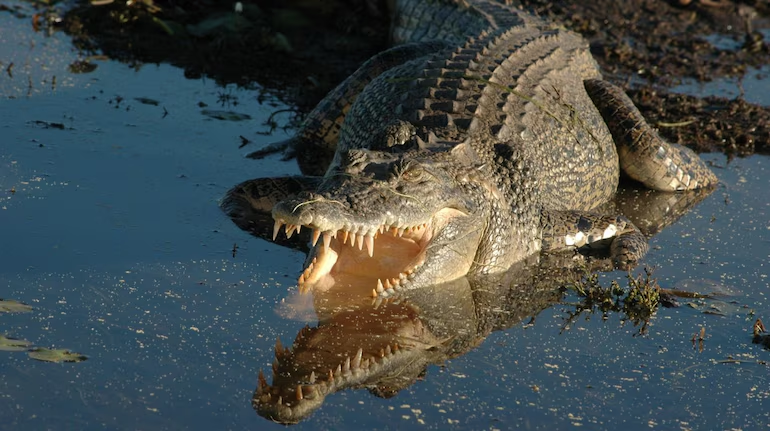- Courses
- GS Full Course 1 Year
- GS Full Course 2 Year
- GS Full Course 3 Year
- GS Full Course Till Selection
- Online Program
- GS Recorded Course
- NCERT (Recorded 500+ Hours)
- Polity Recorded Course
- Geography Recorded Course
- Economy Recorded Course
- AMAC Recorded Course
- Modern India, Post Independence & World History
- Environment Recoded Course
- Governance Recoded Course
- Science & Tech. Recoded Course
- International Relations and Internal Security Recorded Course
- Disaster Management Module Course
- Ethics Recoded Course
- Essay Recoded Course
- Current Affairs Recoded Course
- CSAT
- 5 LAYERED ARJUNA Mentorship
- Public Administration Optional
- ABOUT US
- OUR TOPPERS
- TEST SERIES
- FREE STUDY MATERIAL
- VIDEOS
- CONTACT US
PLACES IN NEWS 16th JANUARY 2025
PLACES IN NEWS 16th JANUARY 2025
16-01-2025

Sultanpur National Park
Why in news?
Sultanpur National Park in Gurugram, Haryana, recently witnessed an extraordinary sighting that thrilled birding enthusiasts—a Falcated Duck. This rare winter migrant, known for its striking plumage with iridescent green and bronze hues, is a prized sight for birdwatchers.
About Sultanpur National Park:
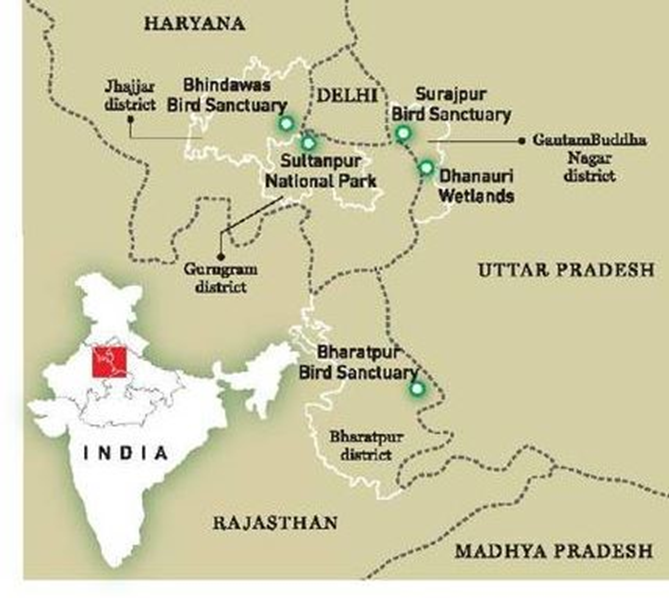
- Location:
- Sultanpur National Park is situated in Sultanpur village, Haryana, on the Gurugram-Jhajjar highway, approximately 15 km from Gurugram and 50 km from Delhi, India.
- The park encompasses around 142.52 hectares, with Sultanpur Lake forming its core area.
- Flora & Fauna:
- The park is renowned for hosting over 220 species of resident, winter migratory, and local migratory waterbirds at critical stages of their life cycles.
- Species such as the common hoopoe, paddy field pipit, purple sunbird, and Indian cormorant are commonly observed.
- During winter, the park attracts species like the Siberian crane, greater flamingo, and northern pintail. In summer, visitors can spot the Asian koel, black-crowned night heron, and blue-cheeked bee-eater.
- The park is also home to animals such as the blue bull (nilgai), Indian fox, and blackbuck.
- Vegetation includes species like babul, kikar, jujube, and neem, providing essential habitat and food sources for the wildlife.
- Conservation Status:
- In recognition of its importance as a wetland of international significance, Sultanpur National Park was designated as a Ramsar site on May 25, 2021.
- The park also supports more than ten globally threatened species, including the critically endangered sociable lapwing (Vanellus gregarius) and the endangered Egyptian vulture (Neophron percnopterus), saker falcon (Falco cherrug), Pallas’s fish eagle (Haliaeetus leucoryphus), and black-bellied tern (Sterna acuticauda).
- Ongoing initiatives focus on protecting the park's wetlands and habitats to ensure a sustainable environment for both resident and migratory birds.
About Falcated Duck:
- The Falcated Duck (Mareca falcata) is a medium-sized dabbling duck known for its striking appearance. Males exhibit metallic green heads, bronze plumage, and distinctive sickle-shaped feathers on their wings, which give the species its name.
- It is native to East Asia and breeds in regions like Siberia, Mongolia, and northern China. During winter, it migrates to South Asia, Southeast Asia, and Japan.
- The Falcated Duck prefers wetlands, lakes, and marshy habitats for feeding and nesting. It primarily feeds on aquatic vegetation, seeds, and small invertebrates. Listed as Near Threatened by the IUCN, it faces threats from habitat loss and hunting.
Pavana River
Why in news?
The National Green Tribunal (NGT) has instructed the state-appointed rejuvenation committee to organize a meeting with stakeholders to establish a revised timeline for executing the action plan to address pollution in the Pavana River.
About Pavana River:

- Origin and path:
- The Pavana River, located in the Pune district of Maharashtra, originates in the Western Ghats, approximately 6 km south of Lonavala. It flows eastward initially before turning southward, passing through areas such as Dehu, Chinchwad, Pimpri, and Dapodi, eventually merging with the Mula River near Pune city.
- The Mula River later joins the Mutha River, forming the Mula-Mutha River, which drains into the Bhima River, the largest tributary of the Krishna River. The Pavana River spans a total length of about 60 km.
- A significant feature of the river is the Pavana Nagar Dam, an earth-fill gravity dam located at Pavana Nagar. The dam is 1,329 meters (4,360 ft) long and 42.37 meters (139 ft) high, with a gross storage capacity of 30,500 km³.
- It was constructed to supply drinking water to Pune and the Pimpri-Chinchwad region, ensuring adequate water resources for these growing urban areas.
- Ecological challenges:
- Despite its significance, the Pavana River faces severe pollution due to the discharge of untreated industrial effluents and domestic sewage. Rapid urbanisation, improper waste management, and encroachments along its banks have further exacerbated the issue.
- The river is burdened with toxic chemicals, heavy metals, and organic pollutants, which harm aquatic ecosystems and threaten water quality. Additionally, solid waste dumping and lack of enforcement of environmental regulations contribute to its deteriorating condition.
- Efforts to rejuvenate the river are ongoing, with authorities focusing on implementing sewage treatment plants, waste segregation, and pollution control measures. Restoring the Pavana River is crucial, as it not only supports drinking water needs but also plays an integral role in maintaining ecological balance in the region.
Shikari Devi Wildlife Sanctuary
Why in news?
- The Government of India has declared the areas surrounding Shikari Devi Wildlife Sanctuary in Mandi district, Himachal Pradesh, as eco-sensitive zones (ESZs).
- This designation aims to minimize the impact of urbanization and developmental activities on the sanctuary's rich biodiversity.
About Shikari Devi Wildlife Sanctuary:
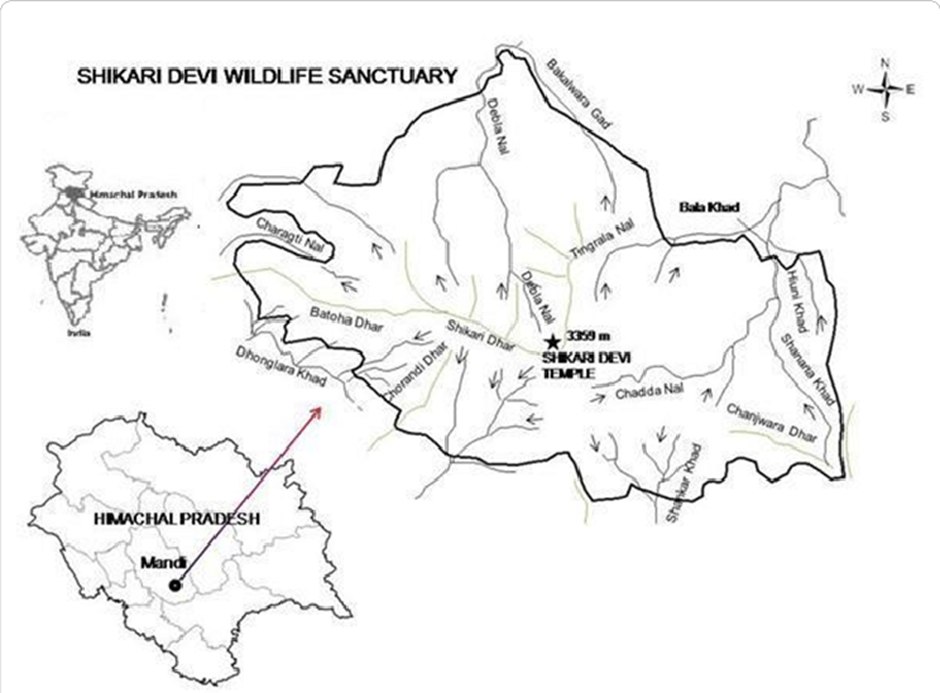
- Location:
- Shikari Devi Wildlife Sanctuary, nestled in the foothills of the Himalayas, is situated in Mandi district, Himachal Pradesh.
- The sanctuary spans elevations from 1,800 to 3,400 meters, showcasing a transition from pine forests through oak woodlands to alpine meadows.
- The sanctuary was established in 1962, encompassing an area of approximately 72 square kilometres.
- The sanctuary derives its name from the Shikari Devi Temple, dedicated to the goddess Shikari Devi. Perched at an elevation of 2,850 meters, the temple is surrounded by snow-capped mountains and dense pine forests, holding significant religious importance for Hindus.
- Flora and Fauna:
- The diverse altitude range contributes to a variety of forest types, including alpine pastures, subalpine forests, moist temperate deciduous forests, West Himalayan upper oak/fir forests, Kharsu oak forests, Western mixed coniferous forests, and ban oak forests. This rich vegetation supports a wide array of wildlife species.
- The sanctuary is home to several species of animals and birds, such as the goral, Himalayan monal, black bear, barking deer, musk deer, leopard, and the Himalayan palm civet. Notably, the snow leopard has also been reported in this area during winter months.
- Ecological benefits of the sanctuary:
- Shikari Devi Wildlife Sanctuary plays a crucial role in preserving the ecological balance of the region. Its diverse habitats support a wide range of flora and fauna, including several endangered species.
- The sanctuary's forests contribute to carbon sequestration, aiding in climate regulation. Additionally, it serves as a vital watershed, ensuring water security for surrounding communities.
- The recent designation of areas around the sanctuary as eco-sensitive zones (ESZs) underscores its ecological importance and aims to mitigate the impacts of urbanisation and developmental activities, ensuring the preservation of its unique biodiversity for future generations.
Colombia
Why in news?
Former Colombian President Álvaro Uribe has publicly called for an international military intervention in Venezuela to depose President Nicolás Maduro and facilitate free elections.
About Colombia:
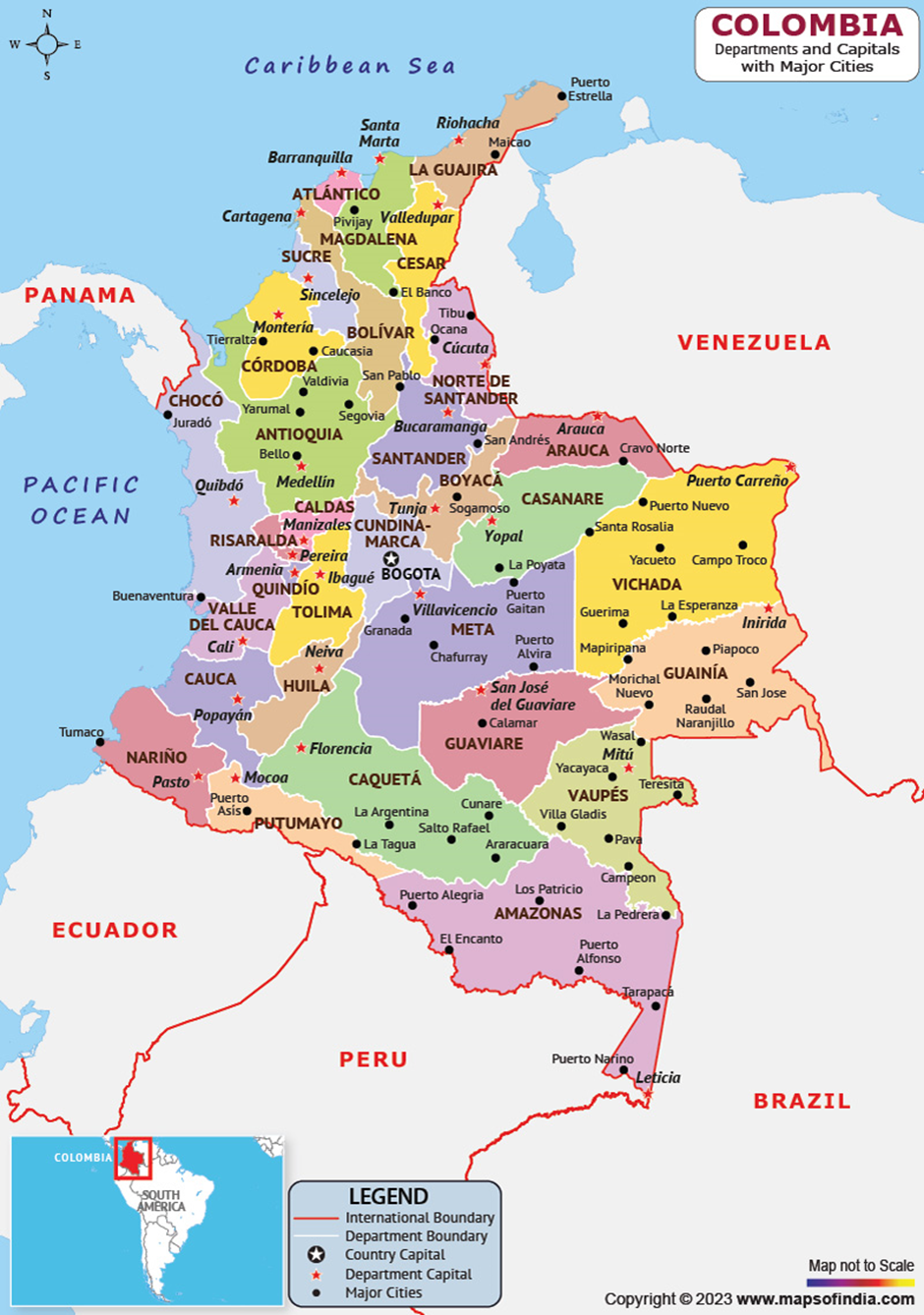
- Location:
- Colombia, located in the northwestern part of South America, shares borders with Panama to the northwest, Venezuela and Brazil to the east, and Peru and Ecuador to the south.
- It is the only South American country with coastlines on both the Caribbean Sea and the Pacific Ocean, enhancing its strategic significance.
- The nation's diverse geography includes the Andes Mountains, Amazon rainforest, Orinoco plains, and Caribbean and Pacific coastlines, contributing to its rich biodiversity.
- Ongoing tensions between Colombia and Venezuela:
- Tensions between Colombia and Venezuela have persisted for years, primarily due to disputes over border regions and political differences.
- The Arauca Department in Colombia and the neighbouring Apure State in Venezuela are frequently in the news due to the presence of armed groups exploiting the porous border for illicit activities.
- These groups impose their own rules, often leading to human rights abuses and undermining state authority.
- In October 2021, Colombia deployed 14,000 soldiers to its border with Venezuela, raising questions about the potential for increased tensions between the two nations.
- Election disputes in Venezuela:
- Venezuela has experienced significant election disputes, particularly surrounding the July 28, 2024, presidential election.
- The opposition and international observers alleged widespread irregularities, including the National Electoral Council's announcement of results without transparent evidence.
- The Supreme Court, perceived as aligned with President Nicolás Maduro, dismissed opposition claims due to a purported lack of evidence.
- These election disputes have led to internal unrest and international condemnation. Protests erupted across Venezuela, with opposition leaders like María Corina Machado urging citizens to demand transparency and democratic processes.
- The international community, including the United States, criticised the electoral process as flawed, asserting that the announced outcomes did not reflect the will of the Venezuelan people.
Ghana
Why in news?
- A statue of Ghana's former President Nana Akufo-Addo, unveiled in November 2024 near the Effia-Nkwanta Regional Referral Hospital in Sekondi, has been destroyed by unknown individuals.
- The incident occurred around 1:30 am on January 14, 2025, resulting in significant damage, with the statue toppled and its upper portion, from the head to the knees, smashed.
About Ghana:
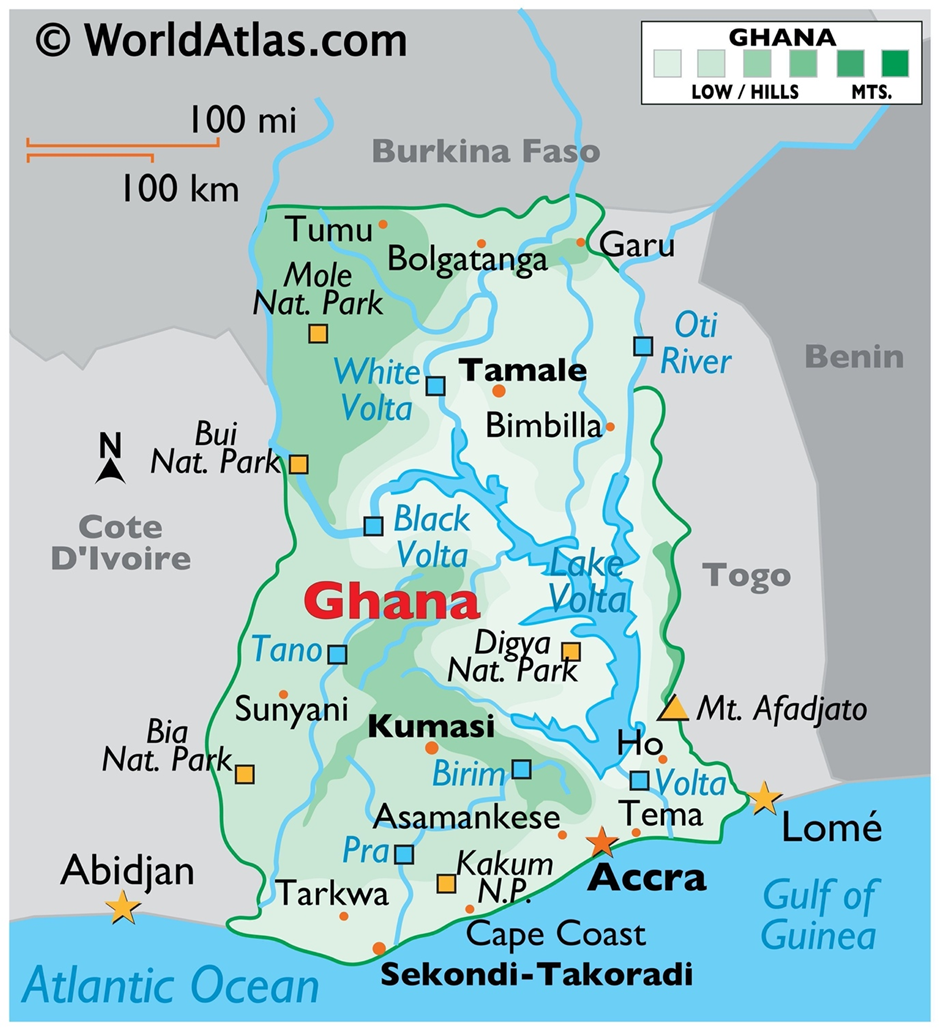
- Geography and Location:
- Ghana, situated in West Africa, lies along the Gulf of Guinea and the Atlantic Ocean, slightly north of the Equator. It shares borders with Côte d'Ivoire to the west, Burkina Faso to the north, and Togo to the east.
- The country encompasses diverse landscapes, including coastal savannas, tropical rainforests, and the Volta Basin, which houses Lake Volta, one of the world's largest artificial lakes. The Greenwich Meridian passes through Ghana, making it geographically significant.
- Natural Resource Potential:
- Ghana is endowed with abundant natural resources. It is a leading producer of gold, contributing significantly to the global market. Other mineral resources include bauxite, manganese, and diamonds.
- The discovery of oil and natural gas reserves has further bolstered the nation's economic prospects. Additionally, Ghana possesses extensive arable land, supporting agriculture, and vast timber resources from its forests.
- The country's hydroelectric power potential is exemplified by the Akosombo Dam on the Volta River, which supplies electricity domestically and to neighbouring countries.
- Regional Multidimensional Conflicts: Ghana, while often regarded as a stable nation in West Africa, faces several regional and multidimensional conflicts that pose challenges to its internal security and social cohesion.
- Ethnic and Chieftaincy Disputes: In the Northern Region, particularly in areas like Bawku, longstanding ethnic tensions between groups such as the Mamprusi and Kusasi have led to recurrent conflicts. These disputes often revolve around chieftaincy titles and land ownership, resulting in violence and displacement.
- Resource-Based Conflicts: The abundance of natural resources has, paradoxically, led to conflicts, especially in regions rich in minerals. Illegal mining activities, known locally as "galamsey," have caused environmental degradation and disputes over land rights. The influx of foreign nationals into these mining areas has sometimes exacerbated tensions with local communities.
- Climate Change and Farmer-Herder Clashes: Climate change has altered traditional grazing patterns, leading to increased migration of Fulani herdsmen into southern Ghanaian territories. This movement has resulted in clashes between herders and local farmers over land and water resources, particularly in the Brong-Ahafo and Eastern Regions.
- Potential Extremist Infiltration: The northern borders of Ghana are increasingly vulnerable to spillover effects from extremist activities in the Sahel region. Reports suggest that militants from neighbouring countries may be using northern Ghana as a logistical base, raising concerns about the potential for radicalisation and recruitment within marginalised communities.
- Addressing these conflicts requires a multifaceted approach, including strengthening local governance structures, promoting equitable resource distribution, enhancing security measures, and fostering interethnic dialogue to maintain Ghana's relative stability in the region.
|
Also Read |
|
UPSC Foundation Course |
|
| CSAT Foundation Course | |


